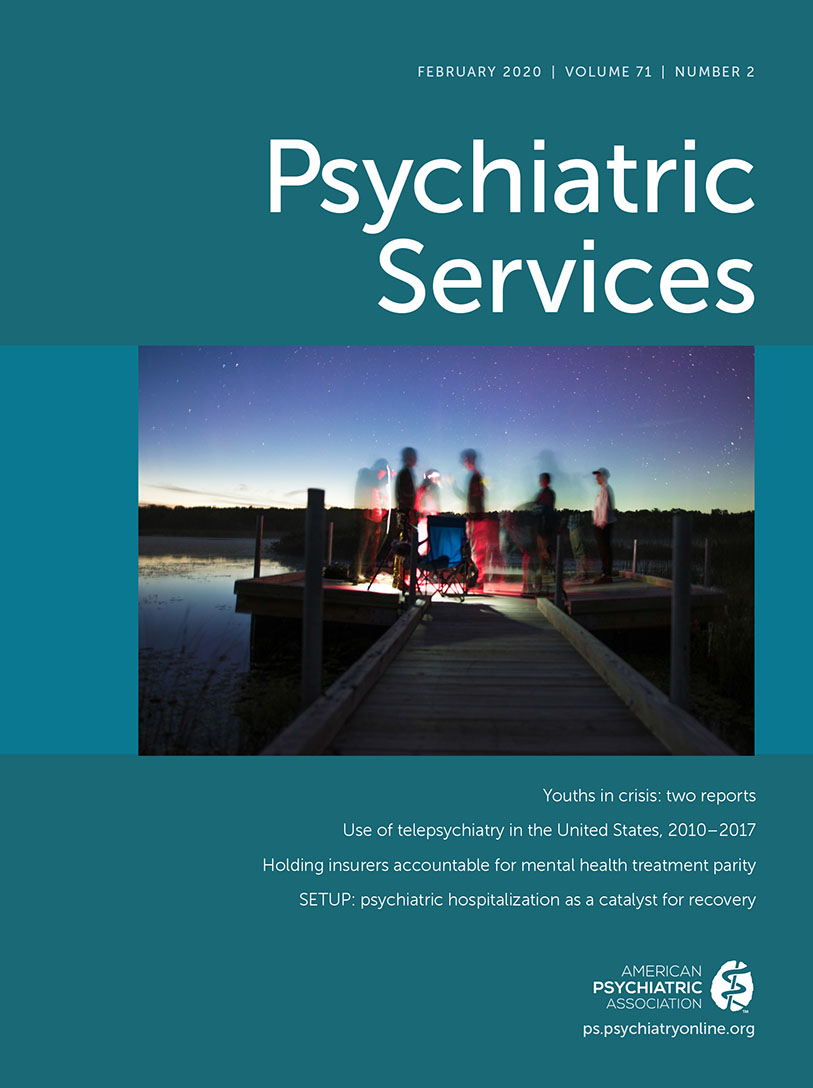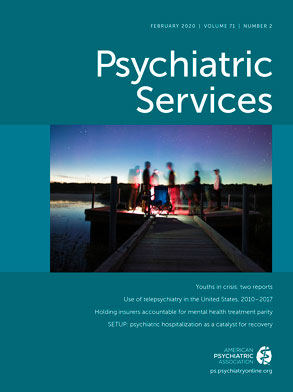Individuals with schizophrenia have more than double the rate of diabetes mellitus compared with the general population (
1). Diabetes-related morbidity contributes substantially to the 60% excess mortality in schizophrenia compared with the general population (
2–
4).
Diabetes care guidelines, which are based on high-quality evidence, suggest that optimal care includes periodic HbA1c, eye, and cholesterol testing (
5,
6). Achieving optimal care and outcomes for a chronic condition is complicated when an individual has multiple chronic conditions (
7–
9). The nature of this interaction for individuals with comorbid schizophrenia and diabetes is largely unknown. Previous investigations have shown that there is a gap in diabetes care quality between those with and without severe mental illness (
10–
12).
Knowing the predictors of diabetes quality of care among individuals with schizophrenia is necessary for developing interventions to improve diabetes-related outcomes for this population. This study describes the determinants and predictors of diabetes quality of care within a population-based sample of individuals with schizophrenia and diabetes.
Methods
We conducted a population-based cohort study of individuals with both diabetes mellitus and schizophrenia in Ontario, the most populous province in Canada (approximately 13.8 million people). (For a description of the service system, see
online supplement.) The Ontario Diabetes Database is a population-based registry of Ontario residents with diabetes (
13). We used the Registered Persons Database to identify demographic information (e.g., age, sex, neighborhood-level income), the National Ambulatory Care Reporting System to identify information related to emergency department visits, and the Canadian Institute for Health Information’s Discharge Abstract Database to identify information related to inpatient medical hospitalizations. The Ontario Mental Health Reporting System was used to identify hospitalizations in psychiatric-designated beds. Claims for physicians’ services were obtained from the Ontario Health Insurance Plan database, which records all inpatient and outpatient physician claims in Ontario. These data sets were linked using unique encoded identifiers and were analyzed at the Institute for Clinical Evaluative Sciences. This study was approved by the research ethics board of the Sunnybrook Health Sciences Centre in Toronto.
We identified patients age 18 or older on April 1, 2011, who had a diagnosis of diabetes and schizophrenia, as defined by validated health care data algorithms (
13). We used a look-back window from April 1, 1991, to April 1, 2011, to identify the time since diagnosis of diabetes and from April 1, 1988, to April 1, 2011, to identify the duration of schizophrenia.
The primary outcome was diabetes quality of care, measured as the number of recommended diabetes screening tests. On the basis of diabetes care guidelines, recommended tests include an eye exam every 2 years, HbA1c testing twice per year (or four times in a 2-year period), and dyslipidemia testing (at least one test in a 2-year period;
5,
6). Optimal care is defined as having four HbA1c tests, one eye test, and one cholesterol test in a 2-year period. The analysis herein focused on comparing characteristics within the schizophrenia population of those who had optimal versus suboptimal diabetes testing and those who had any versus no diabetes testing during a 2-year period from the index date (April 1, 2011–April 1, 2013). Previous work focused on rates of outcomes versus comparator groups without mental illness (
10–
13).
Covariates, or potential risk factors, were classified into three categories: demographic characteristics, illness characteristics, and indicators of access to mental health and nonmental health care (
13). Prior health service utilization was measured in the year before the index date (April 1, 2010–April 1, 2011), with annual primary care visit frequency categorized as low (1–2) or high (≥3).
Baseline characteristics for demographic information, illness characteristics, and service-utilization rates were compiled for the study population by using simple statistics. We modeled the ordinal outcome (number of recommended test components received) as 3 versus <3 and ≥1 versus 0 using cumulative logit regression, adjusting for baseline covariates. We allowed for nonproportional odds in the models. SAS, version 9.4, with the LOGISTIC procedure was used for all modeling. We also conducted sensitivity analyses to remove patients who may have had lab tests done in the hospital because these tests are not captured consistently in the administrative databases. This method included removing patients who had any hospitalizations in the observation period (and who may have had hospital testing that was not captured), removing patients who received care only from psychiatrists (with a significant proportion practicing in hospital settings), and removing patients receiving treatment from primary care physicians who ordered less than three tests per patient per year.
Results
Among 26,259 individuals in Ontario with diagnoses of schizophrenia and diabetes in 2011, 148 (0.6%) were excluded because of missing covariate or outcome data (for baseline characteristics, see online supplement). In the 2 years from the index date, 4,019 individuals (15.3%) had no diabetes care tests, whereas 7,506 (28.6%) had one test, 8,378 (31.9%) had two tests, and 6,356 (24.2%) had all three components of optimal diabetes care testing. Among patients who received only one of the three recommended tests, 5.7% (N=431) received at least four HbA1c tests, 32.7% (N=2,458) received an eye exam, and 61.5% (N=4,617) received at least one cholesterol test.
We found that living in the higher-income neighborhoods, diabetes duration of longer than 5 years, comorbidity score higher than zero, and more outpatient psychiatrist visits were significantly associated with better diabetes care (
Table 1). Being male, being young (18–44 versus 55–64), and having at least one emergency room visit for mental health reasons were significantly associated with worse diabetes care. Having at least one hospitalization was associated with a reduced likelihood of having diabetes testing.
In particular, having three or more nonmental health primary care visits per year (versus having none) was strongly associated with receiving any diabetes testing (odds ratio [OR]=3.02, 95% confidence interval [CI]=2.70–3.38) and with receiving optimal diabetes testing (OR=2.10, 95% CI=1.85–2.39). Having one or two nonmental health primary visits per year (versus having none) was also associated with having any diabetes testing (OR=1.52, 95% CI=1.34–1.72) but was not associated with optimal diabetes testing. There was no association between number of primary care visits for mental health reasons and diabetes testing, except those with three or more annual primary care visits for mental health reasons had lower odds of receiving optimal testing than those with no annual primary care visits for mental health reasons (OR=0.82, 95% CI=0.76–0.89).
In the sensitivity analyses (see online supplement), the trends observed persisted, and there were no significant differences in the results for the significant findings outlined.
Discussion
Many studies have detailed the poor quality of diabetes care among patients with severe mental illness compared with the general population (
10–
12). Our study confirms this finding: one in seven patients received no tests commensurate with good diabetes quality of care, whereas only about one in four patients had all the components of high-quality diabetes care. Many of these previous studies have focused on the quality of diabetes care among patients with severe mental illness, typically defined as patients with diagnoses of schizophrenia, bipolar disorder, and major depression who are psychiatrically hospitalized (
11,
12). To our knowledge, this is the first study that investigated the predictors of diabetes care quality in a population-based sample of individuals with schizophrenia.
Demographic characteristics such as being female and residing in a higher-income neighborhood were associated with better quality of care, in keeping with previous studies identifying socioeconomic status and gender as important factors related to care (
14). Illness characteristics such as longer diabetes duration and higher comorbidity scores were associated with better care. This finding may be due to the fact that those who have had diabetes for longer periods are more likely to have higher HbA1c levels requiring more management and follow-up. Health service–utilization patterns showed that visits to a primary care physician for medical care and an outpatient psychiatrist improved the odds of having better diabetes care. Our main finding of significance shows that prior hospitalization in general and emergency department visits for mental health reasons were associated with poor diabetes quality of care; these may be indicators of psychiatric instability.
Our study showed that patients were substantially more likely to receive recommended diabetes testing if they had three or more nonmental health visits to a primary care provider, whereas having frequent mental health primary visits were associated with worse diabetes care. This finding may explain, in part, previous studies that found that adjusting for overall primary care provider visits did not influence diabetes care quality (
12). Our results suggest that primary care physicians who were able to focus on the medical issues of their patients with schizophrenia, documented through the medical diagnoses associated with their billing, provided better care, whereas those who focused on psychiatric issues were less likely to adhere to diabetes quality guidelines. This pattern is suggestive of “diagnostic overshadowing” (
15), in which challenges emerge in the assessment and management among individuals with competing psychiatric and medical needs.
Our study adds to the body of literature in its focus on factors associated with diabetes quality of care within a schizophrenia population. Strengths of our study include our novel approach by stratifying patients by varying levels of diabetes care within a schizophrenia population. This method allowed us to investigate factors affecting diabetes care quality unique to this patient population and to build on previous work that used a reference population without mental illness. Furthermore, our validated approach in distinguishing between primary care mental health and nonmental health visits allowed us to examine the relationship between a primary care physician’s focus and diabetes care quality.
Limitations of the study included the use of diabetes tests as outcomes for high-quality care because we did not have access to diabetes targets such as serum glucose and HbA1c levels. Another limitation was our method for identifying laboratory tests, which captured all outpatient laboratory tests but did not include tests done in hospitals. Nevertheless, we performed sensitivity analyses to account for this method, and there were no changes in the results. A further limitation of this study was its applicability in differing health systems between jurisdictions, although the previous literature has mostly been conducted in similar single-payer systems.
Conclusions
Our study highlights the challenges of providing high-quality care to people with comorbid schizophrenia and diabetes. We confirmed low rates of recommended diabetes testing in this population, and our findings suggest that this lack of care may be mitigated by frequent primary care visits focused on medical issues, specialist psychiatric care, and psychiatric stability. Models of care (i.e., shared psychiatric care between psychiatrists and primary care providers) may help in addressing this issue. This study points to areas of focus, such as adequate, medically focused primary care contact as well as specialized care to ensure psychiatric stability, when developing interventions to address the high burden of medical illnesses such as diabetes among individuals with schizophrenia.
Acknowledgments
The authors thank Binu Jacob, M.Sc., for her assistance with the statistical analysis.

